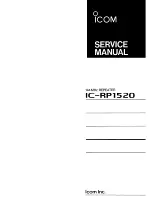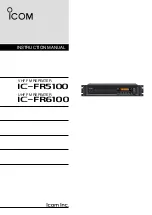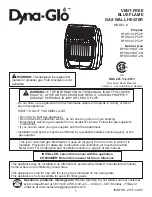
1.
Read all safety precautions and follow L. B. White
recommendations when installing this heater. If
during the installation or relocating of heater, you
suspect that a part is damaged or defective, call a
qualified service agency for repair or replacement.
2.
Position heater properly before use. The heater must
be installed on a level, flat, horizontal and stable
surface when hot or in operation and according to
minimum clearances from combustible surfaces such
as walls, floor or ceilings. Do not place combustible
materials within this zone of clearance. Minimum
safe distances are as follows:
CV100
Top to Ceiling
5 ft.
All Sides
3 ft.
3.
Position the heater and its gas supply hose so as to
protect heater and its gas supply hose from traffic.
Protect hoses with a shielding device of suitable
nature to protect the hose from traffic and movement
or other construction equipment.
4.
The heater is approved for indoor use only.
5.
The heater’s gas pressure regulator (with pressure
relief valve) must be protected from adverse weather
conditions (rain, ice, snow) as well as from building
materials (tar, concrete, plaster, etc.) which can affect
safe operation and could result in property damage or
injury.
6.
Heaters used in the vicinity of combustible tarpaulins,
canvas, plastics, wind barriers, or similar coverings
shall be located at least 10 feet from the coverings.
The coverings shall be securely fastened to prevent
ignition or upsetting of the heater due to wind action
on the covering or other material.
7.
Check all connections for gas leaks using approved
gas leak detectors. Gas leak testing is performed as
follows:
-- Check all pipe connections, hose connections,
fittings and adapters upstream of the gas
control with approved gas leak detectors.
-- In the event a gas leak is detected, check the
components involved for cleanliness and
proper application of pipe compound before
further tightening.
-- Furthermore tighten the gas connections as
necessary to stop the leak.
-- After all connections are checked and any
leaks are stopped, turn on the main burner.
-- Stand clear while the main burner ignites to
prevent injury caused from hidden leaks that
could cause flashback.
-- With the main burner in operation, check all
connections, hose connections, fittings and
joints as well as the gas control valve inlet and
outlet connections with approved gas leak
detectors.
-- If a leak is detected, check the components
involved for cleanliness in the thread areas
and proper application of pipe compound
before further tightening.
-- Tighten the gas connection as necessary to
stop the leak.
-- If necessary, replace the parts or components
involved if the leak cannot be stopped.
-- Ensure all gas leaks have been identified and
repaired before proceeding.
8.
A qualified service agency must check for proper
operating gas pressure upon installation of the
heater.
9.
Light according to instructions on heater or within
owner's manual.
WARNING
Fire or explosion hazard.
Can cause property damage, severe injury or death.
1. To avoid dangerous accumulation of fuel gas, turn off
the gas supply at the heater service valve before
starting installation, and perform gas leak test after
completion of installation.
2. Do not force the gas control pilot button. Use only
normal hand pressure to depress the pilot button.
Never use any tools. If the button will not operate by
normal hand pressure, the control should be
replaced by a qualified service technician. Force or
attempted repair may result in fire or explosion.
7
Installation Instructions
GENERAL
WARNING
Fire and Explosion Hazard
■
Do not use open flame (matches, torches, candles,
etc.) in checking for gas leaks.
■
Use only approved leak detectors.
■
Failure to follow this warning can lead to fires or
explosions.
■
Fires or explosions can lead to property damage,
personal injury or loss of life.




































